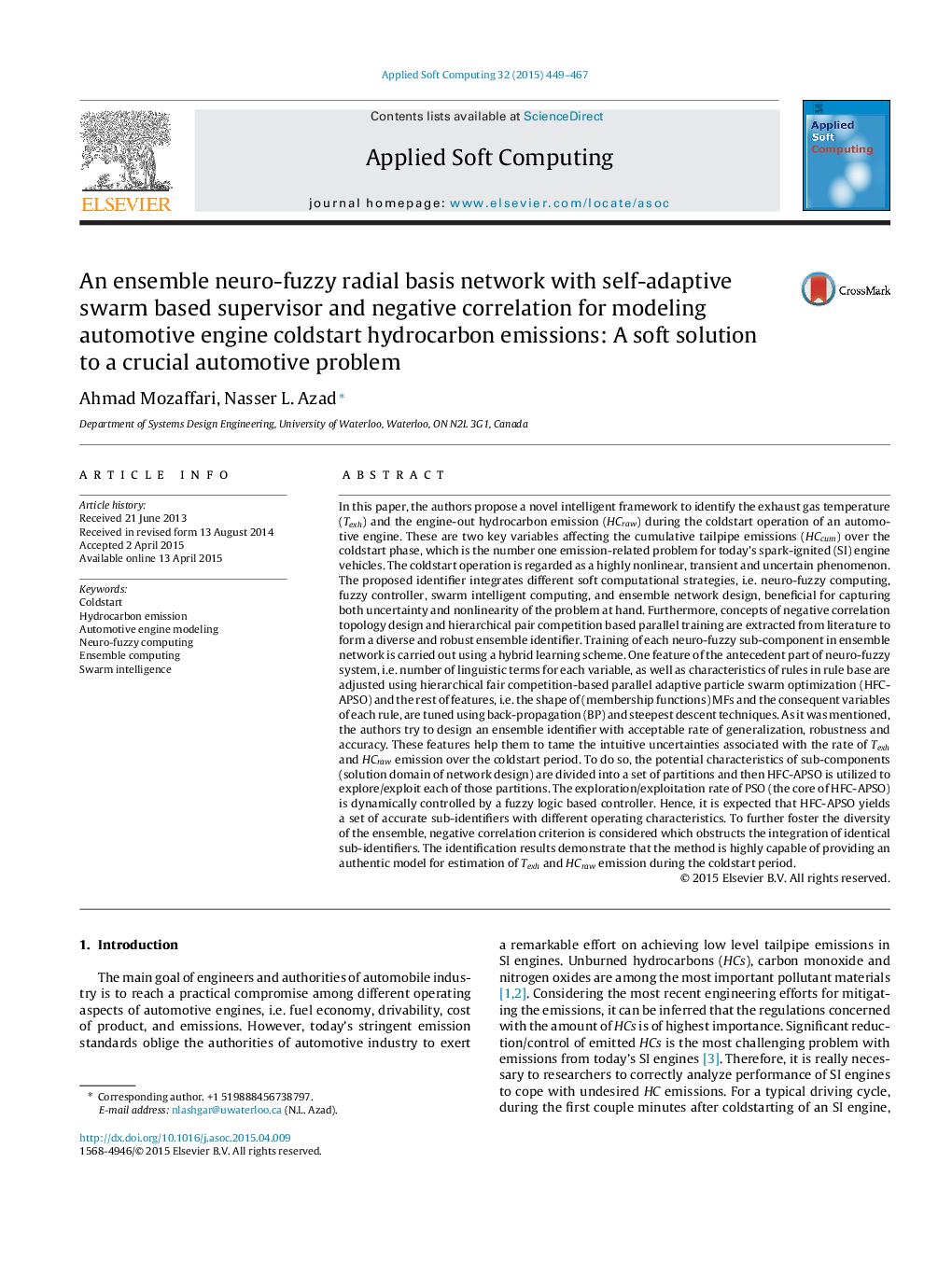| کد مقاله | کد نشریه | سال انتشار | مقاله انگلیسی | نسخه تمام متن |
|---|---|---|---|---|
| 495028 | 862812 | 2015 | 19 صفحه PDF | دانلود رایگان |
• Investigating the applicability of soft computational techniques for identifying the coldstart effect in SI engines.
• Proposing a novel bi-level learning technique to design the structure of neuro-fuzzy identifier.
• Extending the applications of negative correlation based ensemble identifiers to a really important engineering problem.
In this paper, the authors propose a novel intelligent framework to identify the exhaust gas temperature (Texh) and the engine-out hydrocarbon emission (HCraw) during the coldstart operation of an automotive engine. These are two key variables affecting the cumulative tailpipe emissions (HCcum) over the coldstart phase, which is the number one emission-related problem for today's spark-ignited (SI) engine vehicles. The coldstart operation is regarded as a highly nonlinear, transient and uncertain phenomenon. The proposed identifier integrates different soft computational strategies, i.e. neuro-fuzzy computing, fuzzy controller, swarm intelligent computing, and ensemble network design, beneficial for capturing both uncertainty and nonlinearity of the problem at hand. Furthermore, concepts of negative correlation topology design and hierarchical pair competition based parallel training are extracted from literature to form a diverse and robust ensemble identifier. Training of each neuro-fuzzy sub-component in ensemble network is carried out using a hybrid learning scheme. One feature of the antecedent part of neuro-fuzzy system, i.e. number of linguistic terms for each variable, as well as characteristics of rules in rule base are adjusted using hierarchical fair competition-based parallel adaptive particle swarm optimization (HFC-APSO) and the rest of features, i.e. the shape of (membership functions) MFs and the consequent variables of each rule, are tuned using back-propagation (BP) and steepest descent techniques. As it was mentioned, the authors try to design an ensemble identifier with acceptable rate of generalization, robustness and accuracy. These features help them to tame the intuitive uncertainties associated with the rate of Texh and HCraw emission over the coldstart period. To do so, the potential characteristics of sub-components (solution domain of network design) are divided into a set of partitions and then HFC-APSO is utilized to explore/exploit each of those partitions. The exploration/exploitation rate of PSO (the core of HFC-APSO) is dynamically controlled by a fuzzy logic based controller. Hence, it is expected that HFC-APSO yields a set of accurate sub-identifiers with different operating characteristics. To further foster the diversity of the ensemble, negative correlation criterion is considered which obstructs the integration of identical sub-identifiers. The identification results demonstrate that the method is highly capable of providing an authentic model for estimation of Texh and HCraw emission during the coldstart period.
In this research, a novel intelligent framework is proposed to identify the exhaust gas temperature and the engine-out hydrocarbon emission during the coldstart operation of an automotive engine. These are two key variables affecting the cumulative tailpipe emissions over the coldstart phase, which is the number one emission-related problem for today's spark-ignited engine vehicles. The coldstart operation is regarded as a highly nonlinear, transient and uncertain phenomenon. The proposed identifier integrates different soft computational strategies, i.e. neuro-fuzzy computing, fuzzy controller, swarm intelligent computing, and ensemble network design, beneficial for capturing both uncertainty and nonlinearity of the problem at hand. Furthermore, concepts of negative correlation topology design and hierarchical pair competition based parallel training are extracted from literature to form a diverse and robust ensemble identifier. Training of each neuro-fuzzy sub-component in ensemble network is carried out using a hybrid learning scheme. It is observed that the resulted ensemble identifier is capable to conduct the identification with acceptable rate of generalization, robustness and accuracy.Figure optionsDownload as PowerPoint slide
Journal: Applied Soft Computing - Volume 32, July 2015, Pages 449–467
